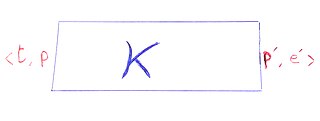
In lambda calculus, the Church–Rosser theorem states that, when applying reduction rules to terms, the ordering in which the reductions are chosen does not make a difference to the eventual result.

In the mathematical field of representation theory, a Lie algebra representation or representation of a Lie algebra is a way of writing a Lie algebra as a set of matrices in such a way that the Lie bracket is given by the commutator. In the language of physics, one looks for a vector space together with a collection of operators on satisfying some fixed set of commutation relations, such as the relations satisfied by the angular momentum operators.
In the field of representation theory in mathematics, a projective representation of a group G on a vector space V over a field F is a group homomorphism from G to the projective linear group where GL(V) is the general linear group of invertible linear transformations of V over F, and F∗ is the normal subgroup consisting of nonzero scalar multiples of the identity transformation (see Scalar transformation).
In mathematics, the theory of fiber bundles with a structure group allows an operation of creating an associated bundle, in which the typical fiber of a bundle changes from to , which are both topological spaces with a group action of . For a fiber bundle F with structure group G, the transition functions of the fiber in an overlap of two coordinate systems Uα and Uβ are given as a G-valued function gαβ on Uα∩Uβ. One may then construct a fiber bundle F′ as a new fiber bundle having the same transition functions, but possibly a different fiber.
In mathematics, computer science, and logic, rewriting covers a wide range of methods of replacing subterms of a formula with other terms. Such methods may be achieved by rewriting systems. In their most basic form, they consist of a set of objects, plus relations on how to transform those objects.
The Knuth–Bendix completion algorithm is a semi-decision algorithm for transforming a set of equations into a confluent term rewriting system. When the algorithm succeeds, it effectively solves the word problem for the specified algebra.
In mathematics, more specifically in group theory, the character of a group representation is a function on the group that associates to each group element the trace of the corresponding matrix. The character carries the essential information about the representation in a more condensed form. Georg Frobenius initially developed representation theory of finite groups entirely based on the characters, and without any explicit matrix realization of representations themselves. This is possible because a complex representation of a finite group is determined by its character. The situation with representations over a field of positive characteristic, so-called "modular representations", is more delicate, but Richard Brauer developed a powerful theory of characters in this case as well. Many deep theorems on the structure of finite groups use characters of modular representations.

In computer science and mathematics, confluence is a property of rewriting systems, describing which terms in such a system can be rewritten in more than one way, to yield the same result. This article describes the properties in the most abstract setting of an abstract rewriting system.
In statistics, M-estimators are a broad class of extremum estimators for which the objective function is a sample average. Both non-linear least squares and maximum likelihood estimation are special cases of M-estimators. The definition of M-estimators was motivated by robust statistics, which contributed new types of M-estimators. However, M-estimators are not inherently robust, as is clear from the fact that they include maximum likelihood estimators, which are in general not robust. The statistical procedure of evaluating an M-estimator on a data set is called M-estimation.
In abstract rewriting, an object is in normal form if it cannot be rewritten any further, i.e. it is irreducible. Depending on the rewriting system, an object may rewrite to several normal forms or none at all. Many properties of rewriting systems relate to normal forms.
In mathematics, computer science and logic, overlap, as a property of the reduction rules in term rewriting system, describes a situation where a number of different reduction rules specify potentially contradictory ways of reducing a reducible expression, also known as a redex, within a term.
The Abstract Rewriting Machine (ARM) is a virtual machine which implements term rewriting for minimal term rewriting systems.
Interaction nets are a graphical model of computation devised by French mathematician Yves Lafont in 1990 as a generalisation of the proof structures of linear logic. An interaction net system is specified by a set of agent types and a set of interaction rules. Interaction nets are an inherently distributed model of computation in the sense that computations can take place simultaneously in many parts of an interaction net, and no synchronisation is needed. The latter is guaranteed by the strong confluence property of reduction in this model of computation. Thus interaction nets provide a natural language for massive parallelism. Interaction nets are at the heart of many implementations of the lambda calculus, such as efficient closed reduction and optimal, in Lévy's sense, Lambdascope.
The derivation of the Navier–Stokes equations as well as their application and formulation for different families of fluids, is an important exercise in fluid dynamics with applications in mechanical engineering, physics, chemistry, heat transfer, and electrical engineering. A proof explaining the properties and bounds of the equations, such as Navier–Stokes existence and smoothness, is one of the important unsolved problems in mathematics.

In mathematics, a Coulomb wave function is a solution of the Coulomb wave equation, named after Charles-Augustin de Coulomb. They are used to describe the behavior of charged particles in a Coulomb potential and can be written in terms of confluent hypergeometric functions or Whittaker functions of imaginary argument.
In mathematical logic and theoretical computer science, an abstract rewriting system is a formalism that captures the quintessential notion and properties of rewriting systems. In its simplest form, an ARS is simply a set together with a binary relation, traditionally denoted with ; this definition can be further refined if we index (label) subsets of the binary relation. Despite its simplicity, an ARS is sufficient to describe important properties of rewriting systems like normal forms, termination, and various notions of confluence.

A critical pair arises in a term rewriting system when two rewrite rules overlap to yield two different terms. In more detail, (t1, t2) is a critical pair if there is a term t for which two different applications of a rewrite rule (either the same rule applied differently, or two different rules) yield the terms t1 and t2.
In rewriting, a reduction strategy or rewriting strategy is a relation specifying a rewrite for each object or term, compatible with a given reduction relation. Some authors use the term to refer to an evaluation strategy.

The theory of causal fermion systems is an approach to describe fundamental physics. It provides a unification of the weak, the strong and the electromagnetic forces with gravity at the level of classical field theory. Moreover, it gives quantum mechanics as a limiting case and has revealed close connections to quantum field theory. Therefore, it is a candidate for a unified physical theory. Instead of introducing physical objects on a preexisting spacetime manifold, the general concept is to derive spacetime as well as all the objects therein as secondary objects from the structures of an underlying causal fermion system. This concept also makes it possible to generalize notions of differential geometry to the non-smooth setting. In particular, one can describe situations when spacetime no longer has a manifold structure on the microscopic scale. As a result, the theory of causal fermion systems is a proposal for quantum geometry and an approach to quantum gravity.

In theoretical computer science, the Krivine machine is an abstract machine. As an abstract machine, it shares features with Turing machines and the SECD machine. The Krivine machine explains how to compute a recursive function. More specifically it aims to define rigorously head normal form reduction of a lambda term using call-by-name reduction. Thanks to its formalism, it tells in details how a kind of reduction works and sets the theoretical foundation of the operational semantics of functional programming languages. On the other hand, Krivine machine implements call-by-name because it evaluates the body of a β-redex before it applies the body to its parameter. In other words, in an expression u it evaluates first λx. t before applying it to u. In functional programming, this would mean that in order to evaluate a function applied to a parameter, it evaluates first the function before applying it to the parameter.











